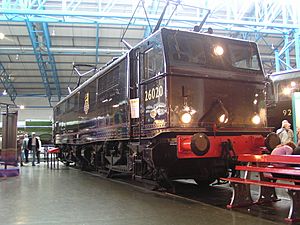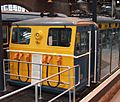British Rail Class 76 facts for kids
Quick facts for kids British Rail Class 76 |
|
 |
|
| Preserved locomotive no. 26020 in original black livery. | |
| Power type | Electric |
|---|---|
| Builder | LNER Doncaster Works (prototype) BR Gorton Works |
| Build date | 1941 (prototype), 1952–1953 |
| Total production | 58 |
| Configuration | Bo+Bo |
| Wheel diameter | 4 ft 2 in (1.270 m) |
| Length | 50 ft 4 in (15.34 m) |
| Locomotive weight | 87.90 long tons (89.3 t) |
| Electric system(s) | 1500 V DC |
| Current collection method | Pantograph, 2 off |
| Traction motors | Metropolitan Vickers |
| Top speed | 65 mph (105 km/h) |
| Power output | Continuous: 1,300 hp (969 kW) One-hour: 1,868 hp (1,393 kW) |
| Tractive effort | 45,000 lbf (200,000 N) |
| Train heating | Steam generator (14 locomotives) |
| Locomotive brakeforce | 72 long tons-force (717 kN) |
| Train brakes | Vacuum, some later Dual |
| Career | British Railways |
| Number | 26000–26055; later E26000–26057; later 76001–76057 |
| Axle load class | Route availability 8 (LNER: 9) |
| Locale | Manchester-Sheffield-Wath line |
| Retired | 1970–1981 |
The British Rail Class 76, also known as Class EM1, was a special type of electric locomotive built for the railways in Britain. These powerful engines were designed to run on 1500 V DC electricity. They were mostly used on the Woodhead Line in Northern England, which was a very busy route for both passenger and freight trains.
Contents
What Was the Class 76?
The Class 76 was an electric train engine. It was known for its strong design, called "Bo-Bo". This means it had two sets of wheels, each with its own motors. This design helped the locomotive pull heavy loads.
Powering Up: How It Worked
These locomotives got their power from overhead electric wires. A special arm on the roof, called a pantograph, collected the electricity. This electricity then powered four large Metropolitan Vickers motors. These motors made the wheels turn, moving the train.
Built for the Woodhead Line
The Class 76 engines were specifically built for the Woodhead Line. This railway line connected Manchester and Sheffield. It was a challenging route with steep hills and long tunnels. Electric locomotives like the Class 76 were perfect for this line. They could pull heavy coal trains and passenger services efficiently.
History of the Class 76
The first Class 76 locomotive was built in 1941. Most of the other 57 engines were built between 1952 and 1953. They were made by LNER at Doncaster Works and by British Rail at Gorton Works.
Life on the Tracks
For many years, the Class 76 locomotives were the main engines on the Woodhead Line. They pulled long trains of coal from mines to power stations. They also carried passengers between cities. Their top speed was around 65 miles per hour.
Retirement of the Class 76
The Woodhead Line closed in 1981. Because of this, the Class 76 locomotives were no longer needed. They were slowly retired from service between 1970 and 1981. Most of them were scrapped, but a few were saved.
Where Are They Now?
Today, you can still see some of these historic locomotives. A few Class 76 engines have been preserved. They are kept in museums or heritage railways. This allows people to learn about these important electric trains. For example, locomotive number 26020 is preserved at the National Railway Museum in York.
Images for kids










